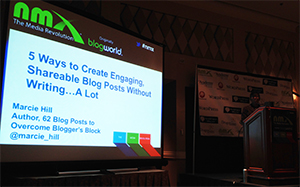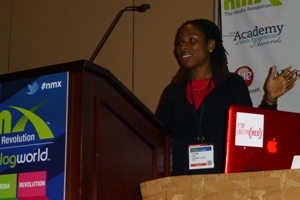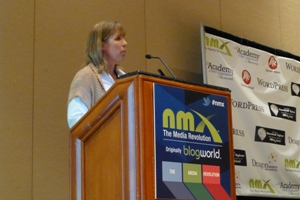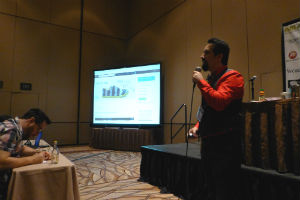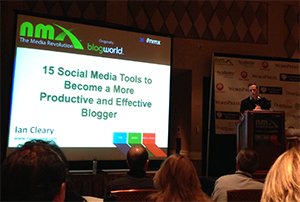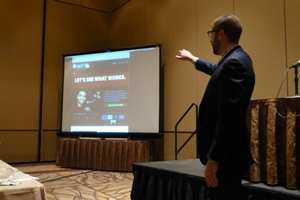|
The What, How and Why of Schema for Bloggers #NMX
 | I use Google more times a day than I should ever admit. I look for restaurants, gas stations, and other businesses around me. I use it for directions, looking up people or places, and occasionally for spelling if I just can’t seem to get that word right. My point is: I expect Google to have the information I want and present it in a way that I can consume at a glance or on-the-go.
Google must think there are others like me because the way they display their results is constantly and dynamically changing to provide more relevant, meaningful information in SERPs. Things like carousels for local results, image and video results, and authorship markup are helping searches find what they wanted, even if they didn't know it.
Schema.org markup can be implemented on websites to help search engines like Google gain a stronger understanding of a page's content, and create those rich snippets we finicky and busy searchers find so useful.
Schema can also be leveraged in the blogging arena. However, it can be hard to know how to explain schema, what types there are, and how to implement. Throw Google+ into the mix and you’re likely to get a tad overwhelmed. Mitch Canter, a veteran front-end developer and WordPress programmer, explained it all during his NMX session.
Why Structured Data is Important
As content creators we are always told we have to write for humans and robots—those crawlers and analytics machines that read and rank our site. We strive to create a balance between the two, but more often than not our content is geared more towards one than the other.
The problem is: search engines aren't humans—they're not thinking, they're processing. As a result, sometimes they can get confused. They might even index your content for something you never even intended it to. That brings your website traffic that has no value.
In order to solve that conundrum you have two options:
- Optimize. But the overkill kind that involves keyword stuffing. Robots used to like this, but humans become alienated and quit reading.
- Structure. Structuring is not just how your content is written, it's in the actual development process and code and a few other elements that help search engines know what the page is about without alienating readers.
What is Schema?
There are several textbook definitions of schema that are mostly very technical and hard to understand. Canter boils it down to: taking human-readable content and taking out the inference layer for the search engines so all they have to do is process the information. They don't have to guess, they can just look and know what's going on.
Essentially, schema takes human-readable content and changes it into search-engine readable content using microdata. (Microdata is an HTML5 specification that allows machine-readable data to be embedded in HTML documents).
How is Schema Implemented?
1). Define the format. This involves some coding which Canter says, "A lot of people look at like guys look at shoe shopping." Coding can be a difficult thing to wrap your head around, but it's not as overwhelming as you think. You'll have to insert a few things into the code on your page:
- itemscope: this tells the search engines/robots that this group is an item. An item, for all intents and purposes, is a collection of all the data we want to use. This element of code will be added to the HTML tag that encloses information about the item.
- itemtype: you’ve indicated that your page has an item with the itemscope code, but now you have to specify what kind of an item it is. You can do so by using the itemtype attribute directly after the itemscope.
2). Assign properties. First you'll have to define some of the properties you'll want to name. Think of a movie for example: there are actors, directors, reviews, ratings and more. All of those things show up differently in search, so it’s important to distinguish what kind of content you have. You'll be using itemprops—an attribute that labels the properties of the content—throughout. A few of the elements you can insert itemprops for include:
- Permalink to the Title: this indicates where other people will go to view the blog post. It's the URL, but we're telling Google this is where people are going to go to see this content.
- Author Information: you want to define the author by linking to their Google+ profile. This will tell Google who wrote the content, and give your authors some credibility and recognition in search.
- Date Published: this lets Google knows when your content was published.
- Keywords: this can be your categories or your tags, depending on which you use most to indicate what the content is mainly about.
What are the Types of Schema?
There are several different kinds of schema that you can implement depending on what kind of content you're creating. Canter covered several during his session and clarified a few things that fall in each category:
- Article: things like news articles or investigative reports fall under this category. Blog posts can fit in here, but there is a specific blog post schema that has come out.
- Review: a review of things like restaurants, movies, stores, books etc.
- Event: an event happening at a certain time in a certain location.
- Person: a person (living dead, undead or fictional) – a definition we all found funny.
- Embeddable Objects: video, audio, images or anything else that is non-text.
- Creative: books, movies, recipes or other creative works.
- Product: anything you are selling or offering. You can break it down to SKU, weight, width, and several other aspects of tangible products.
These can be nested—so you can have a review inside a blog post, or a person inside an event. They also happen to be program agnostic making the possibilities endless!
Is There a Plugin for Schema?
There are a few schema plugins that you can install on your site or blog to help out with some of these technicalities. Schema Creator was mentioned by an audience member. However, if you use a plugin you are constrained to only what the plug in can do, so it does have the potential to limit the possibilities.
Canter offers some advice from a past math teacher, "Learn to do it by hand, then use the technology."
Why Bother with Google+?
You worked really hard to create all of this content, and implement your schema. So why should you bother with Google+? Among other reasons, you can claim your Google Authorship which helps let Google know you own that content, and make a two-way connection between content, your Google+ profile, and your website.
In addition, you get a Rich-Text Snippet. Things like your avatar will appear next to your authored content in SERPs.
How to Set Up Authorship
- Verify your email
- Link to your Google+ profile to your website
- Link your website to your Google+ profile: this helps create the two-way connection between your profile and your website
Schema is a very technical concept and is new enough that not everyone has heard of it and only a handful have actually implemented it. It allows us to do what we do best—writing content that our human readers can infer things from and think critically on, and still dumbs it down for the search engines. Schema lets you have the best of both worlds without having to keyword stuff.
Stay tuned for more liveblog coverage of NMX! For instant updates follow @elizalynnsteely, @benbrausen, @nickehrenberg on Twitter!
|
Becoming A Pinterest Power User and Taking Your Pinning To The Next Level #NMX
 | Social media has the power to drive an insane amount of traffic. While many may not think of it has a source of huge potential, Pinterest drives more traffic than Twitter, LinkedIn, and Reddit combined. But how do you harness the power of this social network powerhouse to drive that traffic to your blog? Cynthia Sanchez, one of TopRank’s 25 Women who Rock Social Media, gave a session on Taking Your Pinterest Account to the Next Level. Her strategies for attracting followers and driving traffic to your blog showed great ways to blow your blog up on Pinterest.
Pinterest's power point is traffic generation-it’s designed to send traffic out. The site’s referral traffic grew 66.52% from 2012-2013. While conversations and things the other social network sites offer are part of Pinterest, sending people out to discoveries is the key. That offers lots of opportunities for your site to be seen. So how do you get seen? Lets look at a number of tips to get the most from your Pinterest presence.
Strategy
Like everything else in marketing, if you go in without a strategy ahead of time, your chances of success are slim. When pinning, keep in mind why people goto Pinterest:
- For something to buy – gift for themselves or friends
- Find information – recipe or tutorial
- Find people with similar interests
- For inspiration – art or design
- For fun
So what do you need to appeal to the things people goto Pinterest for? You need content. The more content you have, the more traffic you will generate. Your site is already full of content, right?
On other sites your content lives once. You post it and it lives in that moment and is shortly forgotten. On Pinterest, if you have something that's seasonal go ahead and re-pin it again when it's relevant.
On top of that, it’s important to lay out your game plan and know your goals.
Make Your Pins Pop
- Keep SEO and keywords in mind. Pinterest SEO goes over into Google SEO, so much so that some pin boards are the ranking number 1 in search. Make sure people have something good to come to, should they find your Pinterest account through search. Make sure your bio includes who you are and what you are offering.
- Have at least 5 pins on each board. If you have less than 5 it's like an empty shelf in a store. It doesn't look complete. If you don't have that many, is it really important enough to have a board for it?
- Provide multiple images within each post. This gives people more options on what they pin. What you think is super pinable might not be and there might be other options people like better.
- Repurpose lists. List posts are very popular on blogs and making a graphic on canvas for that list can make your content very pinable.
- Make your images tall instead of wide. While width of pins is set, length can vary. This is why infographics do so well. They take up a lot of room which makes them hard not to miss. Take advantage of this with long graphics.
You might not have actual content but some text on a graphic can make unrelated images interesting and enticing. Have a great presentation? Turn quotes from it into pins. Quotes are the trading cards of Pinterest. They don't tend to drive traffic back to your site but people love to re-pin them and follow those that post them. Numbered tips are great. If people see #4 and like it, they're going to want to find #3, #2, and #1 too.
Adding Pin It buttons to your site makes it super simple for people to share your content. Also make sure your mobile site works with it. Over 50% of the traffic to Pinterest comes from mobile devices. You could be missing out on huge traffic. Also be aware of the auto-created title from the Pin It button. Use a tool that allows you to customize that description so you can target for the keywords you want to be known for.
Pin to multiple boards. This gives your pin multiple places it can be seen. Not everyone follows all of your boards. You can also experiment with posting the same pin to different boards at different times of day. Not everyone is on at the same time so you might catch different people at different times.
Quick tip: ShotPin is the secret weapon. It's a Chrome browser extension that takes a screenshot of the screen you're on and creates a pin out of it. It will then link back to that page, making pinning quick and easy.
Building A Following
Like any other social network, this takes time. The best place to start is using what you already have. Tell the people on your other networks about your Pinterest. If they like you one place, why wouldn't they like you elsewhere? Be sure to tell them why they should follow you there. What are they going to get? Why will they like it?
Link your Facebook and Twitter accounts so you can follow your those friends and fans on Pinterest. If they follow you on another platform, chances are they'll want to follow you there too.
Strategically follow. Don't just follow in hopes they will follow you back. When you search for those you might want to follow, make sure they have boards that are relevant to what you're sharing too. Why would someone with completely different interests want to follow you and re-pin what you are pinning? Having followers that have no interest in what you're offering is of no value to you and is really a waste of time.
Make sure the people you are pinning are active. Click on the number of pins in their profile. Then click the first pin in the list to find the most recent pin. How old is it? If they haven't been active in months or years, why would it make sense to follow them?
Pinning vs Re-pinning - Want someone to notice you? Don't pin from their site. Go and re-pin the content they've posted on Pinterest. They'll notice it, especially if you pin multiple items. Leave a comment on some of their pins. They'll see you fill their notifications list and take notice. Once they take notice, they might follow back.
Unless you can tie each of your pin boards back into your site somehow, you don't need it. If you sell car parts, why would someone follow a baking recipe board from you? Tie it in with the things you offer. It may take some creativity but it’s possible.
Using these great tips Cynthia laid out in her session, anyone can drive big traffic to their site using Pinterest. Give these great strategies a try for yourself and let us know what kind of traffic increases you see!
Keep your eye out over the next few days for the rest of our NMX coverage. You can follow @BenBrauen, @elizalynnteely, or @NickEhrenberg on Twitter for real-time information!
|
Unleash Your Inner Influencer with Content Marketing #NMX
 | Everyone wants to be valued for their insights, and today's content marketing-fueled age presents multiple opportunities for people to become influencers. I covered how to crowdsource these influencers in an earlier post, but what if you wanted to become one yourself? What does it mean to be an influencer? How do you reach a point where people in your industry are clamoring for your perspective? Finally, how do you build your business from such influence?
It's not as difficult as you think, and it all revolves around efficient content marketing and re-purposing. Serial entrepreneur Chris Ducker outlined the process in an NMX super session, charting the path for people to build their influence.
Ducker, author of The New Business Manifesto, presented a plan for entrepreneurs to build personal/brand influence with content marketing, eventually seeking to launch a business from that attention.
Here are Ducker's five steps for entrepreneurs and content creators looking to build the "Business of You":
1. Identify your niche.
It's difficult to be truly original in this era of content re-purposing. As a result, few ideas are truly original. What separates your content from everything else is personality. Ducker noted that when you build the "Business of You," nobody else can copy it. Before any entrepreneur or content creator can devise unique ideas, they must first identify their own corner of the content generation map. What do you want to write about? What drives you to put pen to paper (or fingers to keyboard/touchscreen)?
2. Know who you are helping.
Now that you have your niche foundation, identify the audience that you're aiming to influence. Ducker insisted that this involves more than simply following them on social media. Building customer profiles can help you focus your efforts on people that have a need for your content. (Note that these are customer profiles, not listener or viewer profiles. Content marketing is still a business, after all.)
3. Create great content.
Content is the gateway to building strong relationships with your followers. Ducker argued that great content should be centered around three main categories:
- Educational – Are you looking to teach or instruct your followers?
- Inspirational – Do you want your followers to be motivated to make change, or perform an action?
- Entertainment – Should the content make them laugh or smile – while still generating attention and conversions?
At first, you won't have the necessary data to hone your content strategy, so you'll need to create content what you think the audience wants. Once you collect feedback and quantify the results, you can then start to create content the audience needs.
4. Build lasting relationships.
We are in a relational business, and connections help drive influence. Ducker referred to this concept as the "people-to-people" (P2P) philosophy, and he saw a lack of it in the sales/marketing industry. Content creators want their fans to connect with them, ask questions, offer feedback, and hang out with them. They must build relationships with their fans and generate a P2P connection. In the end, the audience will determine what the "Business of You" actually becomes.
5. Monetize the brand.
Even with a large social following, it's difficult to generate influence as an entrepreneur unless you monetize your personal brand. It's a difficult aspect to tackle, and many content creators are uncomfortable selling themselves. But Ducker argued that monetizing your brand drives authority, and to be seen as a powerful influencer, you must be "seen to sell."
Ducker proudly proclaimed 2014 as the year for profile content creation and marketing. Such content helps build those P2P relationships, and let loose the influencer inside everyone.
Stay tuned for more from #NMX, and follow @NickEhrenberg, @elizalynnsteely, and @BenBrausen for live coverage on Twitter!
Gain a competitive advantage by subscribing to the
TopRank® Online Marketing Newsletter.
© Online Marketing Blog, 2014. | Unleash Your Inner Influencer with Content Marketing #NMX | http://www.toprankblog.com
|
Read More »

How to Craft Jaw-Dropping Content & Become a Better Writer #NMX
 | Growing up, there was always a battle in my life: school vs. cartoons. School taught me to be structured—the elements of good writing, the processes to follow, the fundamentals. Cartoons taught me to be creative—to think outside the box (thank you Wile E. Coyote), to be creative, and to strive for the eye-bulging, jaw-dropping outcome.
On weekends, cartoons always won out. But Paula Pant, a blogger, journalist and entrepreneur, believes the lessons of cartoons should always triumph. The title of her NMX session, The Art of Crafting Jaw-Dropping Content: Why You Should Forget Everything You Learned in School proves that.
Crafting creative, memorable content that motivates readers to share is the goal of almost every digital marketing agency. Each has it’s own approaches, methods, and beliefs. Regardless, Pant believes that you should "kill your darlings, murder your adverbs, and embrace active tense" through stories, the power of thirds, and your own natural pacing.
But how? Here are a few tips to help writers like you and me create that eye-bulging, jaw-dropping result we all strive for:
Be Simple & Tight with Your Writing
In school we're taught to take a sentence that could be said in 5 words and stretch it out to 15. We are taught to cloud our writing and to make simple things complicated. Forget it. Be direct. Be simple. Ask yourself how to express your thought in the simplest language possible. And never unnecessarily complicate a sentence.
We've all listened to someone tell a story and wished they'd just get to their point. Don't write your blog like that. Write tightly by cutting any extraneous information. Long blog posts are fine, as long as that post is as concise as possible. Cut out any sentences that don't push your reader forward.
Be Clear
- Watch for repetitive verb forms. When you see two similar parts of speech together, try to eliminate one. For example "rather than trying to draw the blueprints" can become "rather than drawing the blueprints”. If you can't eliminate one of the two, group them together. "Buy the medicine and distribute it" becomes "buy and distribute the medicine".
- Start with a subject. It will help your reader know what you’re talking about right away.
- Start with a present tense active verb—especially in lists. They add power right up front in your post and they force you to economize.
Model Your Writing After a Sandwich (Not a Fairytale, Inverted Pyramid, or an Hourglass)
Traditional stories and fairytales follow a format that looks a big like a hill or a bell—they start out slow, climax somewhere in the middle or towards the end, and slow down again. Journalists tend to write in inverted pyramids giving the most newsworthy information first and going down from there. Others write like an hourglass—starting off with the inverted pyramid but adding a twist in the middle to get readers to stick around until the end of the piece.
But Pant's favorite structure is the sandwich. You begin with a face or an anecdote (the bread). Then, progress to the meat of the story—the facts, the details, the data, the research, the tips—the things you want your readers to know. Then, you'll close out with the face. This structure allows you to emotionally connect with your audience, helps get your point across, and gives them a reason to read your entire piece of content.
Be Rhythmic
Every story needs to have rhythm. It isn't just for poetry or for music, it happens in a blog post as well. The best way to include it is to mimic the natural ebb and flow of how people speak. How?
- Alternate long sentences with shorter ones. When we talk, we pause to take a breath. Give your readers time to take a breath—take a sentence.
- Embrace the hyphen. Adding a dash in the middle of a sentence isn't necessarily grammatically correct all the time, but it reflects the way we talk. Your job as a blogger is to bring pixels to life and add character to those pixels.
- Rhyme. Would you remember "an apple a day decreases the risk of coronary failure"? Nope. But you remember "an apple a day keeps the doctor away". It doesn't necessarily make sense, but it's memorable.
- Alliteration sets up a pattern and is easy to do. Create one in your headlines, in your titles, anywhere in your content to help make it a bit more memorable and create rhythm.
- Use onomatopoeia. Write out how something sounds—"Zing" "Woop woop!" or "Briiiiiiing". It catches attention, shortens sentences and is much more interesting to read. Make your content audible.
Be Powerful
Verbs move your story; they sell your story; they're powerful. But they have an enemy. Adverbs. Adverbs enable us to get away with using weak verbs. For example, "he shut the door forcefully". Shut is a weak, overused verb. But "he slammed the door" is much more powerful. Pant advises replacing your adverbs with a powerful, killer verb.
But you don't have to all the time. Occasionally, they're ok to leave in. For example, "he ran faster and fell" being changed to "he ran and fell" conveys two different things. In this instance, the adverb is justified. Imagine you're a publisher paying $2 a word. If it's worth the $2, it can stay. If not, delete it.
Spice Up Your Adjectives
Adjectives like great, wonderful, and fantastic are overused. Try to use ones that aren't. Create cognitive dissonance. Mouthwatering is usually used in regards to food. Use it in a new context—talk about mouthwatering content, or mouthwatering shoes you saw—something to become more memorable.
Be Engaging
Personally, I like to read for fun. I love books that bring you into a different world. I get so wrapped up in the story that I lose track of time, I'll laugh out loud, or get so emotionally connected I can't put the book down even though it's really late. Pant offered a few key tips to help us write like those books:
• Add pops of expression. Example: "they're announcing layoffs on Friday. Yikes!"
• Add teasers and suspense. Example "but that's not all". The reader can't leave—they'll want to know what's next.
• Write in visual metaphors. Example: "teach yourself to read in small sips as well as long swallows" instead of "teach yourself to read in minutes as well as hours".
Creating jaw-dropping, interesting content doesn't have to be hard work. It should be a creative, fun process and should appeal to your readers. Think of things you find interesting in a conversation and try to include those in your writing to resonate with your readers.
How do you convey a voice in your writing without creating nauseatingly-long content?
Be sure to follow the TopRank team at New Media Expo 2014 while we liveblog more of the awesome sessions. @BenBrauen, @elizalynnteely, or @NickEhrenberg
|
| |
